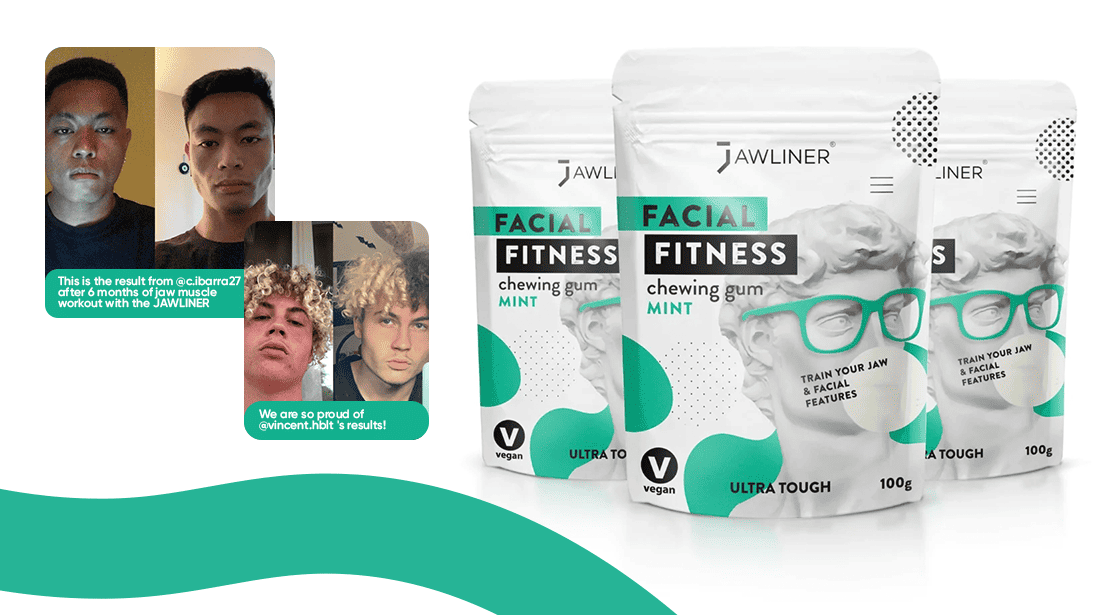If you’ve ever researched mewing or jaw-strengthening exercises, you’ve probably come across the term TMJ. TMJ stands for temporomandibular joint, which is supported by the temporal bone and allows you to move your jaw with the help of your jaw muscles.
When one or both temporomandibular joints don’t work properly, they can cause discomfort and borderline pain. It’s important to understand what can lead to this and how to stop it or, even better, prevent it.
Today, we’ll learn:
-
📖 Everything about the temporomandibular or jaw joint
-
📝 Factors that contribute to jaw pain
- 🧐 Which TMJ exercises relieve pain in the temporomandibular joint (TMJ).

Temporomandibular Joint (TM) – The Most Common Cause of Jaw Pain
If you’ve ever had TMJ pain, you know how much of a negative impact it can have on your day-to-day activities, including speaking, chewing, smiling, and sleeping.
Your well-being can be substantially impacted by TMJ pain. Therefore, seeking solutions to it is a positive step.
You might be asking yourself, “but what’s the actual cause behind TMJ?”. How can I stop the agony and prevent TMJ disorders from happening?
The fact is that there’s no simple explanation as to why you have TMJ pain. The jaw has numerous nerve endings, and even something as simple as extended chewing can result in TMJ pain. People frequently wonder why their jaw hurts in the first place because they may not even have the stimuli for it to occur.
Temporomandibular Joint Disorder (TMD) is the most common root, frequently referred to as TMJ. This condition can negatively influence the joints that unite the jawbone and your skull. Unbelievably, many folks have TMD and go about their regular lifestyle wholly unconscious of it.
Some exercises for TMJ on how you can train and improve your jaw and gonial angle are through mewing. This is the most recent trend that helps with having a powerful, commanding jawline and exceeds specific genetic factors.
Other Factors Causing Sore Jaw Muscles and TMJ Pain
As noted previously, it might be challenging to pinpoint the precise reason for TMJ issues in a person. Other factors causing sore jam muscles could include teeth grinding, malocclusion, arthritis, vascular conditions, or neuropathic pain.
We’ll explore each of these factors in the sections below:
Teeth Grinding
Most people with teeth grinding are unaware of this bad habit until they visit a dentist. This is because teeth grinding typically happens while you’re asleep. Nevertheless, teeth grinding and jaw clenching can occur at any moment for various reasons, such as stress, tension, certain disorders, uneven or missing teeth, pharmaceutical side effects, and irregular biting patterns.
Malocclusion
Malocclusion may cause difficulty or mild jaw pain when chewing or speaking. Trauma, genetics, thumb-sucking, impacted wisdom teeth, and missing teeth that cause the neighboring teeth to drift are a few risk factors.
When it comes to diagnostics, consult a dentist first. To stop the “drift,” he can construct a bridge or crowns.
He may suggest an orthodontist for braces, an oral surgeon for tooth extractions, or, less frequently, surgery to correct the shape of your jaw or remedy poorly-executed prior dental surgeries.
Arthritis
Jaw pain may emerge if certain disorders impact the jaw bone joint. The smooth joint surfaces can deteriorate over time due to osteoarthritis and other types of arthritis. Inflammation in the joints is also brought on by inflammatory diseases such as synovitis, rheumatoid arthritis, and psoriatic arthritis.
Vascular Conditions
An issue can occasionally cause jaw pain in the vascular system. Some examples of vascular disorders are temporal arteritis, sometimes known as giant cell arteritis, and angina.
The arteries in the temple area on each side of the head become swollen in temporal arteritis, causing headaches and jaw pain. A person’s vision may be in danger due to this disorder.
Angina can develop when the heart does not receive enough oxygen-rich blood, usually due to a blood vessel blockage.
Neuropathic Pain
When nerves suffer injury, the brain receives pain impulses, which result in this kind of pain. Persistent symptoms are possible, as well as sporadic ones. Trigeminal neuralgia, postherpetic neuralgia, and cancer-related pain are a few examples of neuropathic pain.
If you’re experiencing any of the above, we’ll now direct you to the top TMJ exercises to remedy the pain.
TMJ Strengthening Exercises
TMJ disorder can be very painful. The good news is that you can perform a variety of jawline exercises at home or at the office to strengthen your jaw and ease soreness.
These seven exercises could improve the movement of your jaw joints and reduce TMJ symptoms:
#1. Mewing Technique
Mewing, the habit of having your tongue in the appropriate position, is becoming increasingly popular in the health and wellness industries. If you haven’t heard about the meaning behind mewing, it seeks to improve facial symmetry and jawline strength and minimize several other health concerns by altering one’s tongue location against the roof of the mouth through conscious (and then unconscious) modification.
#2. Resisted Mouth Opening
To perform the resisted mouth closing exercise, start by placing your thumbs under your chin and your index finger in the space between your chin and the bottom jaw. As you close your mouth, gently press the chin downward with your thumbs and fingers.
This exercise helps strengthen the jaw muscles and improve jaw mobility.
#3. Jaw Clenches
To perform TMJ exercises like jaw clenches, start by gently but firmly clenching your jaw muscles for a few seconds, then release. Repeat this process several times, gradually increasing repetitions as your jaw muscles strengthen.
This exercise helps improve jaw stability and alleviate symptoms of temporomandibular joint disorder (TMJ) by promoting muscle strength and flexibility. Remember to perform the exercises slowly and avoid overexertion to prevent further strain on the jaw muscles.
#4. Tongue Presses
For this exercise, gently press your tongue against the roof of your mouth with moderate pressure for several seconds, then release. This tongue exercise engages the jaw muscles, promoting strength and coordination to alleviate symptoms of temporomandibular joint disorder (TMJ).
#5. Gum Chewing
This one is straightforward, just simply chew sugar-free gum for a few minutes each day, focusing on the repetitive chewing motion to strengthen the jaw muscles. This exercise helps increase muscle endurance and improves overall jaw function. We recommend trying Jawliner Facial Fitness chewing gum for this exercise.

TMJ Stretching Exercises
#6. Mouth Opening and Closing
To perform this mouth exercise, begin by gently opening your mouth as wide as is comfortable. Hold this position for a few seconds to allow the jaw muscles to stretch and relax. Then, gradually close your mouth in a slow and controlled manner.
This exercise helps improve jaw mobility and alleviate tension in the jaw muscles.
#7. Side-to-Side Movements
To perform this jaw exercise, start by sitting or standing in a comfortable position with your spine aligned. Slowly and gently move your jaw to one side as far as you can without causing pain or discomfort. Hold this position for a few seconds, then return your jaw to the center. Repeat the movement on the opposite side.
This exercise helps improve jaw mobility and flexibility.
#8. Chin Tucks
To perform this neck exercise, maintain proper posture with your shoulders back and chest puffed out. Imagine you’re a soldier standing at attention. Pull your chin back into your neck as if you’re trying to hold an apple between your chin and neck. You may notice a temporary double chin, but with consistency, it will diminish over time.
Repeat this movement ten times, holding the ‘apple’ position for three seconds each time. This exercise helps strengthen the muscles in your neck and improve posture.
#9. Forward Jaw Movement
The lower jaw is moved forward and backward while a wooden stick or plastic spoon is placed between the upper and lower teeth as part of the activity.
Initially, you may experience some discomfort with this forward movement, but with consistent practice, the exercise will become more tolerable and help in the jaw’s recovery.
TMJ Relaxation Techniques
#10. Deep Breathing Exercises
Find a comfortable seated or lying position with your spine straight and shoulders relaxed. Begin by inhaling deeply through your nose, allowing your abdomen to expand as you fill your lungs with air. Hold your breath for a few seconds, then exhale slowly and completely through your mouth, allowing your abdomen to contract.
Focus on the sensation of the breath entering and leaving your body, and try to make each inhale and exhale as deep and controlled as possible
#11. Progressive Muscle Relaxation (PMR)
Begin by finding a quiet and comfortable space to lie down or sit in a relaxed position. Close your eyes and take a few deep breaths to center yourself. Start with your toes, curling them tightly for a few seconds before releasing the tension and allowing them to relax completely. Then, move on to the muscles in your feet, calves, thighs, and so on, gradually working your way up to your jaw and facial muscles.
As you tense and release each muscle group, focus on the sensations of tension melting away and the muscles becoming loose and relaxed.
#12. Guided Imagery and Visualization
Imagine a peaceful scene like a beach or forest. Focus on your breath, inhaling deeply through your nose and exhaling fully through your mouth. Relax your jaw and facial muscles as you visualize the calming scene. Stay in this state for a few minutes, then slowly bring your awareness back to the present moment.
#13. Neck and Shoulder Stretches
To perform this exercise, follow these 4 easy steps:
- Neck Tilts: Gently tilt your head to each side, holding for 10-15 seconds.
- Neck Rotations: Slowly rotate your head from side to side, feeling the stretch.
- Shoulder Rolls: Roll your shoulders forwards and backwards, completing several rotations.
- Shoulder Stretch: Bring one arm across your chest and hold for 10-15 seconds, then switch sides.
Perform each stretch slowly and gently, focusing on your breath and relaxing into the movements to alleviate muscle tension.
TMJ Functional Exercises
#14. Chin Tucks with Resistance
Place your fingertips lightly against your chin.
Slowly tuck your chin towards your chest while simultaneously applying gentle resistance with your fingertips, pushing against the movement.
Hold this position for a few seconds, then release the resistance while returning your chin to the neutral position.
#15. Resistance Band Exercises
To perform resistance band exercises for the jaw, select an appropriate band tension and sit or stand comfortably.
For jaw opening, place the band around your chin and slowly open your mouth against the resistance. Hold briefly, then release.
For jaw closing, position the band around the outside of your jaw and gently close your mouth against the resistance. Hold briefly, then release.
#16. Finger Resistance Exercises
Use your fingers to apply gentle resistance against the jaw while performing lateral or protrusive movements. This helps strengthen jaw muscles and improve muscle control.
Start with gentle pressure and gradually increase as muscles strengthen.
TMJ Postural Exercises
#17. Postural Alignment
Focus on aligning your head directly above your shoulders, avoiding any forward jutting or tilting to the side.
Imagine a string pulling gently upward from the crown of your head, lengthening your spine and promoting proper posture.
Additionally, engage your core muscles slightly to provide stability and support to your upper body.
#18. Chin Tucks with Postural Correction
Align your ears directly over your shoulders to ensure proper posture. Then, gently tuck your chin towards your chest, focusing on lengthening the back of your neck while keeping your gaze forward. Hold this position for a few seconds, feeling the stretch along the back of your neck.
As you perform the chin tuck, maintain the alignment of your ears over your shoulders to reinforce good posture.
Incorporate TMJ Exercises Into Daily Routine
Incorporating TMJ exercises into your daily routine can be incredibly beneficial for managing TMJ pain and promoting relaxation in the mouth and tongue.
Here are some savvy tips to seamlessly weave these relaxation-inducing moves into your busy day:
- Set Aside Dedicated Time: Schedule a specific time each day for your TMJ exercises. Whether it’s in the morning, during a break, or before bed, having a consistent schedule makes it easier to stick to the routine.
- Create a Relaxing Environment: Find a calm space where you won’t be interrupted and set the mood with soft lighting and soothing music. Creating a peaceful environment can help you unwind and fully engage in your exercises.
- Listen to Your Body: Pay attention to how your jaw feels during the exercises and adjust them as needed. If you’re feeling tense, opt for gentler stretches and focus on deep breathing to relax your muscles.
- Integrate Throughout the Day: Incorporate short TMJ exercises into your daily activities, such as while sitting at your desk or waiting in line. These brief moments of self-care can help alleviate tension in your jaw muscles.
- Stay Consistent: Make TMJ exercises a regular part of your routine, even on busy days. By practicing them daily, you’ll experience greater improvements in jaw mobility and overall well-being.
Armed with these strategies and a dedication to weaving TMJ exercises into your daily agenda, you’ll swiftly bid adieu to TMJ pain and welcome a sense of peaceful calmness into your life.
Key Takeaways
TMJ disorders may get better on their own. However, if your symptoms don’t go away, and you struggle to relieve TMJ pain, TMJ exercises might help to reduce pain.
When experiencing extreme discomfort, you shouldn’t perform TMJ exercises. The AAFP advises delaying starting a TMJ exercise program until your pain has subsided.
Start slow when performing jaw exercises. At first, you could have some discomfort, but it should pass quickly. Consult your doctor if the pain is intolerable. TMJ exercises should be performed when you’re at ease, and they could be ineffective if your muscles are strained.
Remember, you can always treat TMJ with mewing to improve your jawline and facial structure today!





